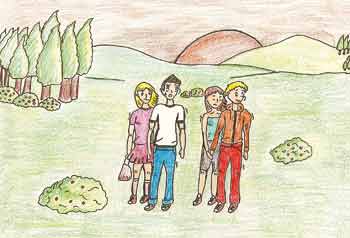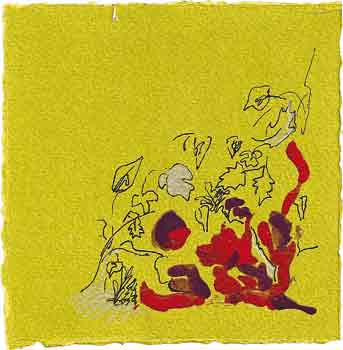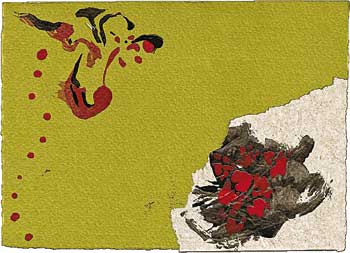| |
THE STRANGE INHABITANT OF THE FOREST
Introduction and comments by Cristina Maffei Suomi
Author: Laura Ylikoski (age 12)
The literature of fables, myths and legends has recently been re-evaluated. These forms originally belonged to the oral tradition of literature but were then recognized and used at both a literary and a didactic level to form a deeper understanding of the historical, anthropological and folkloristic origins of a people. I think the term “folkloric” is significant, being only tentatively used as it evokes non-academic elements of tradition not therefore considered a true expression of a community’s culture. Conversely, I believe this term is important in that it defines the progress of primitive ritualistic origins to modern popular tradition, as it is understood as a collection of tales and stories forming the literary inheritance not just of a linguistic group but for the whole of humanity. In fact the themes in question remain the same, regardless of territorial and sociological implications, being based initially in the unconsciousness of man and then becoming the cultural inheritance for man’s knowledge. The fantastic imagery which is at the basis of every story is rich in symbolism and incorporates within it allegorical references essential to life: earth, water, air and light which can symbolize safety and fear, life and death, darkness and light. The story under consideration features all these elements, expressed in a context that acts as the perfect scene for countless tales stemming from many cultures: the forest, the wild wood in all its forms and meanings. Who represents the dichotomy between good and evil better than the spirit that lives in this forest, with its numerous real and fantastic forms of life? Whoever has knowledge of the wood knows that such a personification is not so very far from reality: the impressions that you experience whenever you enter the wood spark off an ancient and latent memory underlying the immediate visual impressions and provokes hidden emotions which are at the basis of human feeling. In the past, the wood was the source of sustenance and survival while nowadays we go into it for leisure, for an interest in nature, for curiosity, but above all for a wish for adventure. We unconsciously live it and see it through the amazed eyes of the heroes in this story; we are swallowed up in the wood and feel it to be impenetrable, fascinating and dangerous, but also magic, intimate and protective. We go back to our childhood, confirming the primordial innocence and purity which existed in the simple and mutual relationships which bound man to nature in the past. The log on which the children place their gifts in honour of the spirit of the forest is perhaps a pagan altar at which we should metaphorically reflect when we come face to face with nature and re-appropriate for ourselves its most ancient features and its most precious teachings.
Laura Ylikoski
THE STRANGE INHABITANT OF THE FOREST
 It was a beautiful day. Liisa, Petteri, Kalle and Toini were going into the forest to collect blueberries and lingonberries. After crossing the field of waving golden corn, they arrived at the edge of the forest. Liisa swung her bucket to and fro, a sign that it was now time to enter the forest. In the forest it was a bit darker. The shadows of the fir trees were cast on the ground, making the air feel fresher. From time to time, the sun peeped in between the branches, warming slightly the faces of the children. It was a beautiful day. Liisa, Petteri, Kalle and Toini were going into the forest to collect blueberries and lingonberries. After crossing the field of waving golden corn, they arrived at the edge of the forest. Liisa swung her bucket to and fro, a sign that it was now time to enter the forest. In the forest it was a bit darker. The shadows of the fir trees were cast on the ground, making the air feel fresher. From time to time, the sun peeped in between the branches, warming slightly the faces of the children.
After walking for a bit, Toini noticed a blue patch of myrtles. “Look at that! We can get at least two bucketfuls!” the children cried, and so picked up their buckets and filled them with myrtles. “I haven’t filled mine up, don’t let’s go yet,” said Petteri to the other children, who had already filled their buckets. “Of course you haven’t filled yours. You’ve eaten at least half a bucketful,” said Liisa and knelt down to help Petteri.
At last they managed to fill Petteri’s bucket. “Why don’t we pick another bucket of red myrtle berries?” asked Kalle, swinging the empty bucket. “Sure, let’s keep picking,” agreed Toini. The children walked further into the darkening forest, holding each other by the hand. Then, from behind a huge rock covered with moss, they heard a rustling noise.
The children were terribly frightened. Petteri gave a cry; if it had been a squirrel, it would have run away. But the rustling continued. Petteri shouted again and only then did something rise up from behind the rock. It looked like a man. A man the same height as Toini’s father gazed at them. The children went pale, shivers running down their spines; their fear was in their toes and in their ears and screamed so loudly that some of them must have burst their eardrums!
The apparition also seemed to be afraid of them as he backed away from the children’s screams and also began to shout. Toini, Kalle, Petteri and Liisa ran away, but they couldn’t find the path home in such dark forest.
“Hey! Don’t run off, children! I don’t want to hurt you, I won’t eat you!” shouted the man, and the children stopped. “Who-who-who are you?” stammered Petteri timidly, who was usually very brave. “Me? Don’t you know? You should know, my lad, that I keep all this forest alive! I protect the plants, I sow the moss, I water the trees and give strength to the stones. Now do you know who I am?” asked the man. “No”, said Petteri meekly. “Would you not know even if I told you that I have very fast legs and that I can run like any other animal in the forest? Or would you know who I am if I told you that I am both herbivorous and carnivorous?” the man then asked. “No,” Petteri said again. “Well, would you know if I told you I was the creator of all the forest?” asked the man, in frustration. “No,” said Petteri once again. “I, who am standing in front you, am Tapio, the Spirit of the Forest!” The children’s faces went pale and the shivers went down their spines, they wanted to cry for fear. “You are the great Tapio, the Spirit of the Forest?” asked the children timidly. “Of course!”
A long moment passed. The children gazed at the man. The man whose face moved but had no eyes, no mouth or nose. The man had incredibly long beard and hair. He was wearing a dark green tunic which stretched to the ground, it was so long that the plants, the moss, the mushrooms and the trees grew around it. To tell the truth, that tunic was the earth itself. “What are you doing in my forest, on my land?” asked Tapio, gazing at the children’s buckets with his expressionless face. Toini told him the whole story. “Ah, so it’s like that,” said Tapio at the end. “Children, you should know that if someone dares to touch the berries that grow on my land, then in the evening he has to bring me a bucket of milk and some bread. If these things are not ready on the edge of the forest in the evening, I will come to take you from your homes and will take you to the Son of the Forest, my child, who will make you dance without respite until you are exhausted!” said Tapio, and disappeared into the forest carried by the wind. The children stood in silence. “Let’s go at once to get the milk and the bread,” cried Liisa and they all ran directly back to the smelly cowshed.
 Liisa grabbed a stool and went up to the cow Konttikatti. With all her strength she began pulling the cow’s udders and eventually the bucket was full of milk. Meanwhile, Kalle went to his house to fetch the bread which had been left to dry on the beam hanging from the ceiling. Now everything was ready and the children ran quickly across the big field towards the edge of the forest. “Should we leave them here?” asked Kalle doubtfully. The other children nodded. Petteri noticed a log and suggested putting the milk and bread on top of it. Liisa lifted the bucket onto the log, Kalle put the bread next to it and then everybody stood silent. Liisa grabbed a stool and went up to the cow Konttikatti. With all her strength she began pulling the cow’s udders and eventually the bucket was full of milk. Meanwhile, Kalle went to his house to fetch the bread which had been left to dry on the beam hanging from the ceiling. Now everything was ready and the children ran quickly across the big field towards the edge of the forest. “Should we leave them here?” asked Kalle doubtfully. The other children nodded. Petteri noticed a log and suggested putting the milk and bread on top of it. Liisa lifted the bucket onto the log, Kalle put the bread next to it and then everybody stood silent.
Finally, they heard a murmuring from the forest: “Thank you children!”
Toini, Kalle, Petteri and Liisa were frightened, but eventually they turned to face the edge of the forest and said: “You’re welcome, great Tapio, Spirit of the Forest.”
So everything was alright again. The Son of the Forest would not make them dance until they fainted and they wouldn’t be forced to stay in the forest forever, so they returned home happily.
This story is part of a book called “Nuove storie per antiche leggende” (New stories from old legends), the result of a co-operative project between Italy and Finland.
The purpose of the joint effort is to encourage exchanges between the two countries in various fields of cultural interest and, in particular, to promote the specific nature of each land, from rediscovering cultural roots to taking a new look at old legends.
Drawings by pupils Francisco Javier Herrera Rubio y Alberto Horcajo Zazo of class 4ª of school IES Siberia Extremeña (Badajoz).
|
|